Sustainable Innovation Management Model (MGI) for Agro-Industrial Citrus Chain
Abstract
1. Introduction
2. Theoretical Framework
2.1. Context and Concepts of the Citrus Agro-Industrial Chain
2.2. Citrus Agro-Industrial Chain in Colombia
2.3. Innovation and Sustainability Models
3. Materials and Methods
3.1. Phase 1
3.2. Phase 2
3.3. Phase 3
3.4. Phase 4
4. Results
4.1. Phase 1
4.2. Phase 2
4.3. Phase 3
- Congruence: Each expert evaluated whether the content of each item included in the questionnaire reflected the specified objectives and scored “1” if the content was specified, “−1” if they believed it did not measure it, and “0” if there were doubts about whether it measured it.
- Relevance: Each expert evaluated whether the content of each item included in the questionnaire reflected the relevance of each item on a Likert scale from 1 to 5 to measure the proposed objective, from “not relevant at all” (1) to “completely relevant” (5).
4.4. Phase 4
4.4.1. MGI 1: Lineal
4.4.2. MGI 2: Generic Interactive
4.4.3. MGI 3: Strategic Alignment and Innovation
5. Discussion
5.1. Axis 1
5.2. Axis 2
5.3. Axis 3
6. Conclusions
7. Recommendations
- Active Engagement of Senior Management: It is essential that senior leadership demonstrate a clear and unwavering commitment to the MGI’s implementation by dedicating necessary resources and providing strategic direction for its execution.
- Comprehensive Organizational Involvement: The process of MGI implementation should involve all organizational levels, fostering active participation and ensuring the commitment of employees to the management of ideas, innovation, and organizational change.
- Training and Capacity-Building: Adequate training programs focused on MGI concepts, tools, and methodologies should be provided to all members of the organization, ensuring that they possess the necessary skills to contribute effectively to the innovation process.
- Fostering an Innovative Organizational Culture: A culture that encourages creativity, innovative thinking, and experimentation should be cultivated. This will promote the generation and exchange of ideas within the organization.
- Phased Implementation: It is advisable to begin the MGI implementation in specific areas of the organization, with the intention of gradually expanding to other departments or processes. This phased approach allows for continuous adjustments and improvements during the rollout.
- Establishing Monitoring and Evaluation Mechanisms: Mechanisms for monitoring and evaluating the progress and outcomes of MGI implementation should be established. These data can be used to make ongoing adjustments and refine the process as necessary.
- Collaboration and Knowledge Sharing: Companies should actively seek collaboration with other firms, research institutions, and government agencies. Participation in innovation networks can facilitate the exchange of knowledge, experiences, and best practices, thus fostering the development of the citrus sector
Author Contributions
Funding
Institutional Review Board Statement
Data Availability Statement
Acknowledgments
Conflicts of Interest
References
- Eugenio, R.G.R.; Reinoso, M.D.R.V.; Romero, D.J. Estrategia empresarial: Una reflexión teórica. Rev. Cienc. Soc. 2024, 30, 411–424. [Google Scholar]
- Ministerio de Agricultura y Desarrollo Rural. Citrus Chain. Indicators and Instruments. 2021. Available online: https://sioc.minagricultura.gov.co/Citricos/Documentos/2019-06-30%20Cifras%20Sectoriales.pdf (accessed on 18 March 2025).
- United States Department of Agriculture—USDA. Citrus: Global Markets and Trade. 2024. Available online: https://apps.fas.usda.gov/psdonline/circulars/citrus.pdf (accessed on 18 March 2025).
- Perea-Dallos, M.; Ramírez, L.P.M.; Perea, A.T. (Eds.) Biotecnología Aplicada al Mejoramiento de los Cultivos de Frutas Tropicales; Universidad nacional de Colombia, Sede Bogotá, Facultad de ciencias, Departamento de biología: Bogotá, Columbia, 2010. [Google Scholar]
- Rojas, J.J.B.; Cano, J.A.; Giraldo, M.D. Apertura económica y política comercial: Estudio del sector lácteo y sus dificultades en Colombia. Rev. Venez. Gerenc. RVG 2020, 25, 846–868. [Google Scholar] [CrossRef]
- de Morais, J.P.G.; Campana, M.; Del Valle, T.A.; Moreira, T.G.; da Silva, E.D.R.; do Prado, R.F.; de Oliveira, R.E. Inclusion of babassu bran produced in milk production in Amazonia. Trop. Anim. Health Prod. 2021, 53, 527. [Google Scholar] [CrossRef] [PubMed]
- Dernat, S.; Etienne, R.; Hostiou, N.; Pailleux, J.Y.; Rigolot, C. Ex-post consequences of participatory foresight processes in agriculture. How to help dairy farmers to face outcomes of collective decisions planning? Front. Sustain. Food Syst. 2022, 6. [Google Scholar] [CrossRef]
- Martinelli, R.R.; Damasceno, J.C.; de Brito, M.M.; da Costa, V.D.V.; Lima, P.G.L.; Bánkuti, F.I. Horizontal collaborations and the competitiveness of dairy farmers in Brazil. J. Co-Oper. Organ. Manag. 2022, 10, 100183. [Google Scholar] [CrossRef]
- Bianchi, A.E.; Reichen, C.; Borges, L.I.; Santos, J.G.R.; Rudek, L.; Fernandes, S.R.d.S.; de Morais, O.R.; Monteiro, A.L.G. Análise estratégica da cadeia produtiva de leite ovino no Brasil: Uma abordagem pela metodologia SWOT. Semin. Ciências Agrárias 2023, 44, 971–988. [Google Scholar] [CrossRef]
- Congreso de la República de Colombia (Ley 811 (Junio de 2003)). Productive Chains. Bogotá D.C. 2003. Available online: https://www.minambiente.gov.co/wp-content/uploads/2021/06/ley-811-2003.pdf (accessed on 10 March 2025).
- Siembra. Plataforma de Información Para la Gestión del Conocimiento en Ciencia, Tecnología e Innovación, (CTI) del Sistema Nacional de Innovación Agropecuaria. 2025. Available online: https://www.siembra.co/HomeNew (accessed on 19 February 2025).
- Merchán, D.; Maldonado, E.; Palacios, I.; Herrera, D. Análisis del desarrollo de la agroindustria en el Ecuador. Rev. Estrateg. Desarrollo Empresarial 2017, 3, 19–24. [Google Scholar]
- Davis, J.H.; Goldberg, R.A. A Concept of Agribusiness; Harvard University Press: Boston, MA, USA, 1957. [Google Scholar]
- Rodríguez, N.; Linares, A.; Hernández, M. Qualitative and quantitative analysis of scientific contributions in agribusiness. Sci. Agropecu. 2021, 12, 435–444. [Google Scholar] [CrossRef]
- Clark, T.; Charter, M. Sustainable Innovation: Key Conclusions from Sustainable Innovation Conferences 2003–2006 Organised by the Centre for Sustainable Design; University College for the Creative Arts: Surrey, UK, 2007. [Google Scholar]
- Escamilla-Fajardo, P.; Núñez-Pomar, J.M.; Ratten, V.; Crespo, J. Entrepreneurship and innovation in soccer: Web of science bibliometric analysis. Sustainability 2020, 12, 4499. [Google Scholar] [CrossRef]
- Bos-Brouwers, H.E.J. Corporate sustainability and innovation in SMEs: Evidence of themes and activities in practice. Bus. Strategy Environ. 2010, 19, 417–435. [Google Scholar] [CrossRef]
- Pichlak, M.; Szromek, A.R. Eco-innovation, sustainability and business model innovation by open innovation dynamics. J. Open Innov. Technol. Mark. Complex. 2021, 7, 149. [Google Scholar] [CrossRef]
- Colpas, F.; Tarón, A.; Fuentes, L. Innovación social y sostenibilidad en América Latina: Panorama actual. Rev. Espac. 2019, 40, 13. [Google Scholar]
- Salazar, M.D.P.R.; Uribe, R.P.; Durán, F.F.M. Modelo RISE (Ruta de innovación y sostenibilidad empresarial) para analizar la felicidad en el trabajo. Rev. Estrateg. Organ. 2023, 12, 91–108. [Google Scholar] [CrossRef]
- Sarabia, N.; Peris, J. Emergence and Development of Transformative Capacities for the Sustainability of the Agri-Food System: The Process in Valdivia, Chile. Sustainability 2024, 16, 4849. [Google Scholar] [CrossRef]
- Bayona-Saez, C.; Cruz-Cázares, C.; García-Marco, T.; García, M.S. Innovación abierta en la industria de alimentos y bebidas. Manag. Decis. 2017, 55, 526–546. [Google Scholar] [CrossRef]
- Kastelli, I.; Tsakanikas, A.; Caloghirou, Y. Technology transfer as a mechanism for dynamic transformation in the food sector. J. Technol. Transf. 2018, 43, 882–900. [Google Scholar] [CrossRef]
- Adekunle, A.; Lyew, D.; Orsat, V.; Raghavan, V. Helping Agribusinessses—Small Millets Value Chain—To Grow in India. Agriculture 2018, 8, 44. [Google Scholar] [CrossRef]
- Della Corte, V.; del Gaudio, G.; Sepe, F. Innovación y empresas basadas en la tradición: Un estudio de casos múltiples en el sector agroalimentario. Br. Food J. 2018, 120, 1295–1314. [Google Scholar] [CrossRef]
- Arku, J.K.; Shao, Y.; Ankrah, S.T. Building a Hierarchical Enablers Framework for Service Business Model Innovation for Sustainable Performance: Evidence from Ghana’s Electricity Sector. Sustainability 2024, 16, 3191. [Google Scholar] [CrossRef]
- D’Itria, E.; Pei, X.; Bertola, P. Designing Sustainability Today: An Analytical Framework for a Design for Sustainability Model in European Fashion and Furniture Industries. Sustainability 2024, 16, 3240. [Google Scholar] [CrossRef]
- Forrest, J.F. Practitioners’ forum: Models of the process technological innovation. Technol. Anal. Strateg. Manag. 1991, 3, 439–453. [Google Scholar] [CrossRef]
- Fertő, I.; Molnár, A.; Tóth, J. Ideas sin fronteras: Innovación abierta en la cadena alimentaria húngara. Br. Food J. 2016, 118, 1494–1515. [Google Scholar] [CrossRef]
- Meynard, J.; Jeuffroy, M.; Le, M.; Lefèvre, A.; Magrini, M.; Michon, C. Designing coupled innovations for the transition to sustainability of agri-food systems. Agric. Syst. 2017, 157, 330–339. [Google Scholar] [CrossRef]
- Faure, G.; Barret, D.; Blundo-Canto, G.; Dabat, M.H.; Devaux-Spatarakis, A.; Le Guerroué, J.L.; Hainzelin, E. How different agricultural research models contribute to impacts: Evidence from 13 case studies in developing countries. Agric. Syst. 2018, 165, 128–136. [Google Scholar] [CrossRef]
- Cillo, V.; Rialti, R.; Bertoldi, B.; Ciampi, F. Knowledge management and open a innovation in agrifood crowdfunding. Br. Food J. 2019, 121, 242–258. [Google Scholar] [CrossRef]
- Johnston, A. Open Innovation and the formation of university links in the Food manufacturing and Technology sector: Evidence form the UK. Eur. J. Innov. Manag. 2021, 24, 89–107. [Google Scholar] [CrossRef]
- Saren, M.A. Classification and review of models of the intra-firm innovation process. R&D Manag. 1984, 14, 11–24. [Google Scholar] [CrossRef]
- Carrillo-Barbosa, Y. A Tendencias de Investigación en las Cadenas de Suministro de Frutales: Un Análisis Basado en Revisión de Mapeo [Research Trends in Fruit Supply Chains: A Mapping Review Analysis]. Eur. Public Soc. Innov. Rev. 2024, 9, 1–17. [Google Scholar] [CrossRef]
- Díaz-Canel Bermúdez, M.M.; Delgado Fernández, M. Gestión del gobierno orientado a la innovación: Contexto y caracterización del Modelo. Rev. Univ. Sociedad 2021, 13, 6–16. [Google Scholar]
- Franco Castro, A.; Zartha Sossa, J.W.; Solleiro, J.L.; Montes, J.M.; Vargas Martínez, E.E.; Palacio Piedrahita, J.C.; Hoyos Concha, J.L. Proposal of innovation management model for a final consumer sales company. Rev. Lasallista Investig. 2018, 15, 75–89. [Google Scholar] [CrossRef]
- Chesbrough, H.; Bogers, M. Explicating Open Innovation: Clarifying an Emerging Paradigm for Understanding Innovation; New Frontiers in Open Innovation; Oxford University Press: Oxford, UK, 2014; pp. 3–28. [Google Scholar]
- Christensen, C.; Raynor, M.; McDonald, R. What is Disruptive Innovation? Harvard Business Review. 2015. Available online: https://www.interaction-design.org/literature/book/the-encyclopedia-of-human-computer-interaction-2nd-ed/disruptive-innovation?p=b248 (accessed on 18 March 2025).
- Lares, L.; Henríquez, A. Diseño Regenerativo y Economía Circular. Cuadernos del Centro de Estudios en Diseño y Comunicación. Ensayos 2021, 134, 19–34. [Google Scholar]
- Palacios-López, L.A. Nuevas tendencias e innovaciones para una agricultura sostenible. Horiz. Nexus J. 2024, 2, 15–28. [Google Scholar] [CrossRef]
- Gil, B.; Pascual-Ezama, D. La metodología Delphi como técnica de estudio de la validez de contenido. An. Psicol. Ann. Psychol. 2012, 28, 1011–1020. [Google Scholar] [CrossRef][Green Version]
- Du, J.; Li, P.; Guo, Q.; Tang, X. Measuring the knowledge translation and convergence in pharmaceutical innovation by funding-science-technology-innovation linkages analysis. J. Informetr. 2019, 13, 132–148. [Google Scholar] [CrossRef]
- Kumar, U.S.; Shrivastava, R.L.; Rajasree, O.P. Quality factors and performance in citrus industry. Int. J. Product. Qual. Manag. 2018, 25, 480–490. [Google Scholar] [CrossRef]
- AENOR UNE 166002:2021; Gestión de la I+D+i. Requisitos del Sistema de Gestión de la Investigación, el Desarrollo y la Innovación. Asociación Española de Normalización: Madrid, Spain, 2021. Available online: https://www.une.org/encuentra-tu-norma/busca-tu-norma/norma?c=N0065421 (accessed on 18 March 2025).
- Ocotlán, B.P.M.; Solleiro, R.J.L. La Gestión de la Innovación en Empresas Farmacéuticas Mexicanas. 2013. Available online: https://www.elibrary.ru/item.asp?id=23433766 (accessed on 18 March 2025).
- Escorsa Castells, P.; Valls Pasola, J. Tecnología e Innovación en la Empresa; Edicions UPC: Barcelona, Spain, 2003. [Google Scholar]
- Rosenberg, N. Uncertainty and technological change. In The Economic Impact of Knowledge; Routledge: London, UK, 2009; pp. 17–34. [Google Scholar]
- Aldaz, J.C.C.; Cortez, J.L.P.; López, M.C.; Jacome, S.S.I. Adaptabilidad en el sistema de producción agrícola: Una mirada desde los productos alternativos sostenibles. Rev. Cienc. Sociales 2020, 26, 308–327. [Google Scholar]
- Chen, S.H.; Lee, R.S. A new innovation model: Interdisciplinary creative value-adding toward commercialization. In Proceedings of the 2013 1st International Conference on Orange Technologies (ICOT), Tainan, Taiwan, 12–16 March 2013; pp. 164–167. [Google Scholar] [CrossRef]
- Hincapié, J.M.M.; Martínez, E.E.V.; Concha, J.L.H.; Piedrahita, J.C.P.; Rincón, J.F.A.; Fernández, G.L.R.; Sossa, J.W.Z. Priority technologies and innovations in the fishing agribusiness by the year 2032. Foresight study through the Delphi method. Rev. Lasallista Investig. 2017, 14, 105–120. [Google Scholar] [CrossRef]
- Leckel, A.; Veilleux, S.; Dana, L.P. Local Open Innovation: A means for public policy to increase collaboration for innovation in SMEs. Technol. Forecast. Soc. Change 2020, 153, 119891. [Google Scholar] [CrossRef]
- Diener, K.; Luettgens, D.; Piller, F.T. Intermediation for open innovation: Comparing direct versus delegated search strategies of innovation intermediaries. Int. J. Innov. Manag. 2020, 24, 2050037. [Google Scholar] [CrossRef]
- Suárez, L.M.; Agudelo, D.A.; Zartha, J.W.; Orozco, G.L. La cadena productiva de mora en el Departamento Risaralda en el marco de un estudio de prospectiva a 2032. Sci. Technica 2021, 26, 183–190. [Google Scholar] [CrossRef]
- Quintero, J.; Suárez, L.; Escobar, N.; Meza, C.; Jaramillo, J.; Agudelo, D.; Zartha, J.; Orozco, G. Sectorial Foresight Studies as an Input for Training and Research in Agroindustrial Process Engineering. In Proceedings of the 18th LACCEI International Multi-Conference for Engineering, Education, and Technology, Virtual, 27–31 July 2020, ISSN 2414-6390. [Google Scholar] [CrossRef]
- Grass Ramírez, J.F.; Muñoz, R.C.; Zartha Sossa, J.W. Innovations and trends in the coconut agroindustry supply chain: A technological surveillance and foresight analysis. Front. Sustain. Food Syst. 2023, 7, 1048450. [Google Scholar] [CrossRef]
- Farias, P.I.V.; Freire, E.; Cunha, A.L.C.D.; Grumbach, R.J.D.S.; Antunes, A.M.D.S. The fertilizer industry in Brazil and the assurance of inputs for biofuels production: Prospective scenarios after COVID-19. Sustainability 2020, 12, 8889. [Google Scholar] [CrossRef]
- Barcaccia, G.; D’Agostino, V.; Zotti, A.; Cozzi, B. Impact of the SARS-CoV-2 on the Italian agri-food sector: An analysis of the quarter of pandemic lockdown and clues for a socio-economic and territorial restart. Sustainability 2020, 12, 5651. [Google Scholar] [CrossRef]
- Meza, D.; Quintero, J.; Zartha, J.; Hernández, Z. Estudio de prospectiva del sector cacao al año 2032 como base de programas de capacitación universitaria en el sector agroindustrial. Apl. Método Delphi Inf. Tecnol. 2020, 31, 219–230. [Google Scholar] [CrossRef]
- Zartha Sossa, J.W.; Palacio Piedrahita, J.C.; Orozco Mendoza, G.L.; Hincapié Llanos, C.A.; Ríos Mesa, A.F.; Álvarez López, C. Prospective of Agroindustrial Engineering in Ibero-America to 2035: Application of the scenario methodology and the Delphi method. Cienc. Tecnol. Agropecu. 2023, 24. [Google Scholar] [CrossRef]
- Vollenbroek, F.A. Sustainable development and the challenge of innovation. J. Clean. Prod. 2002, 10, 215–223. [Google Scholar] [CrossRef]
- Salas Canales, H.J. Tecnologías limpias como fuente de ventaja competitiva empresarial. Academo 2020, 7, 97–104. [Google Scholar] [CrossRef]
- Zapata, C.; Nieuwenhuis, P. Exploring innovation in the automotive industry: New technologies for cleaner cars. J. Clean. Prod. 2010, 18, 14–20. [Google Scholar] [CrossRef]
- Galaz, V.; Biermann, F.; Folke, C.; Nilsson, M.; Olsson, P. Global environmental governance and planetary boundaries: An introduction. Ecol. Econ. 2012, 81, 1–3. [Google Scholar] [CrossRef]
- Severo, E.A.; de Guimarães, J.C.F.; Dorion, E.C.H.; Nodari, C.H. Cleaner production, environmental sustainability and organizational performance: An empirical study in the Brazilian Metal-Mechanic industry. J. Clean. Prod. 2015, 96, 118–125. [Google Scholar] [CrossRef]
- de Oliveira Vasconcelos, D. Parques eco-industriais na China: Modelo de desenvolvimento sustentável? Um estudo de caso do Parque Industrial de Suzhou. Rev. Ciências Hum. 2022, 1. [Google Scholar]
- Franzò, S.; Doppio, N.; Natalicchio, A.; Frattini, F.; Mion, L. Designing innovation contests to support external knowledge search in small and medium-sized enterprises. Technovation 2023, 121, 102684. [Google Scholar] [CrossRef]
- Montoya, L.H.B.; Sossa, J.W.Z.; Piedrahíta, J.C.P.; Mendoza, G.L.O.; Montoya, A.F.R.; Pérez, W.A.P. Innovation management model for functional food ingredients and additives. Alignment with hype cycle, Python S-curves, and open innovation variables. J. Open Innov. Technol. Mark. Complex. 2024, 10, 100365. [Google Scholar] [CrossRef]
- Solarte-Montufar, J.G.; Zartha-Sossa, J.W.; Osorio-Mora, O. Open innovation in the agri-food sector: Perspectives from a systematic literature review and a structured survey of MSMEs. J. Open Innov. Technol. Mark. Complex. 2021, 7, 161. [Google Scholar] [CrossRef]
- Rothwell, R. Towards the fifth-generation innovation process. Int. Mark. Rev. 1994, 11, 7–31. [Google Scholar] [CrossRef]
- Kline, S.; Rosenberg, N. An Overview of Innovation, the Positive Sum Strategy: Harnessing Technology for Economic Growth; National Academy Press: Washington, DC, USA, 1986. [Google Scholar]
- Marquis, D.G. The anatomy of succeful innovations. Natl. Sci. Found. Tech. Peport 1969, 69, 28–37. [Google Scholar]
- Kumar, V. 101 Design Methods: A Structured Approach for Driving Innovation in Your Organization; John Wiley & Sons: Hoboken, NJ, USA, 2012. [Google Scholar]
- Roberts, E.B.; Frohman, A.L. Strategies for improving research utilization. Technol. Rev. 1978, 80, 32–39. [Google Scholar]
- Mazzucato, M.; Kattel, R.; Ryan-Collins, J. Las políticas de innovación impulsadas por retos: Hacia nuevas herramientas de política. Cuad. Cendes 2021, 38, 25–52. [Google Scholar]
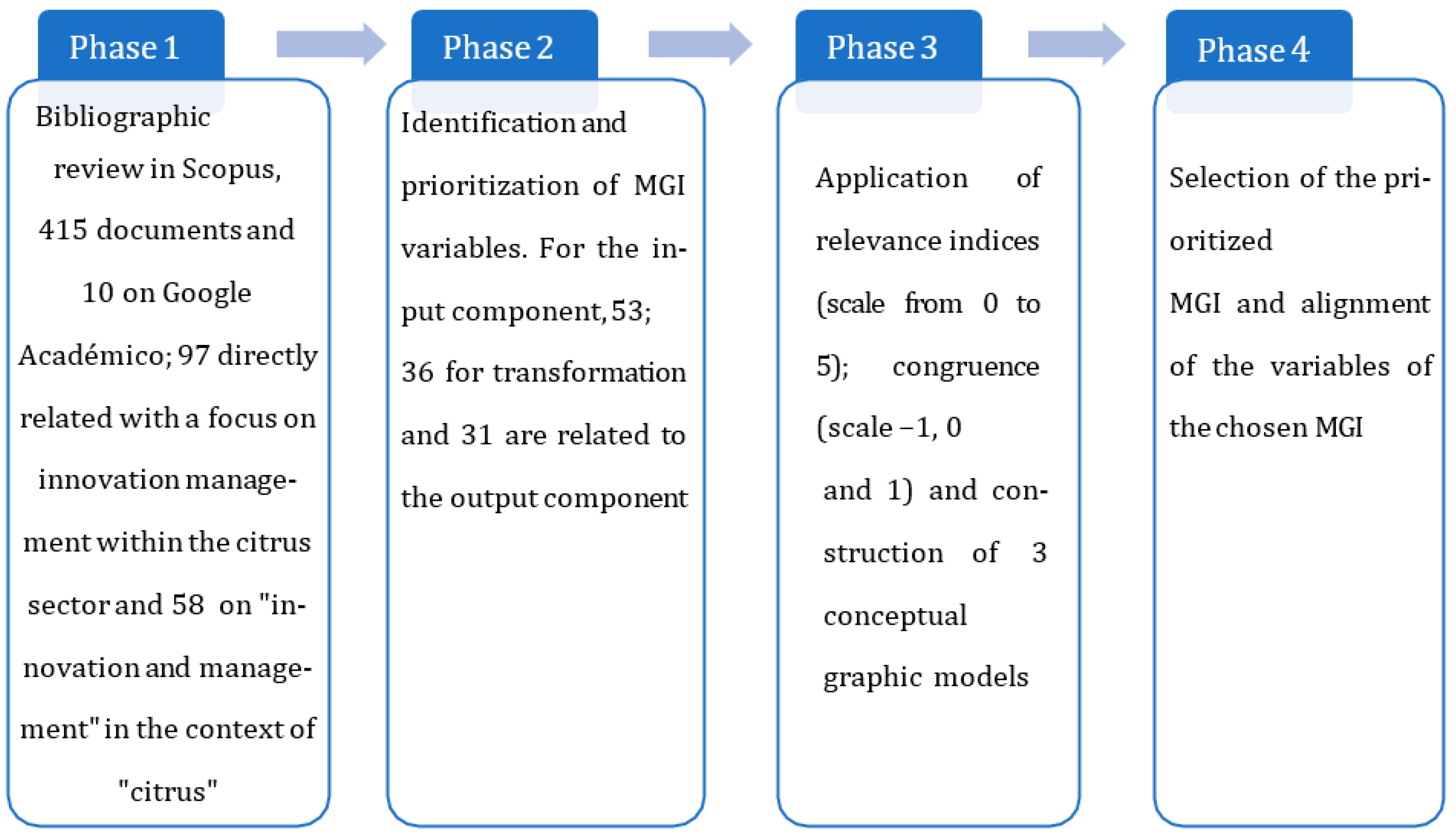
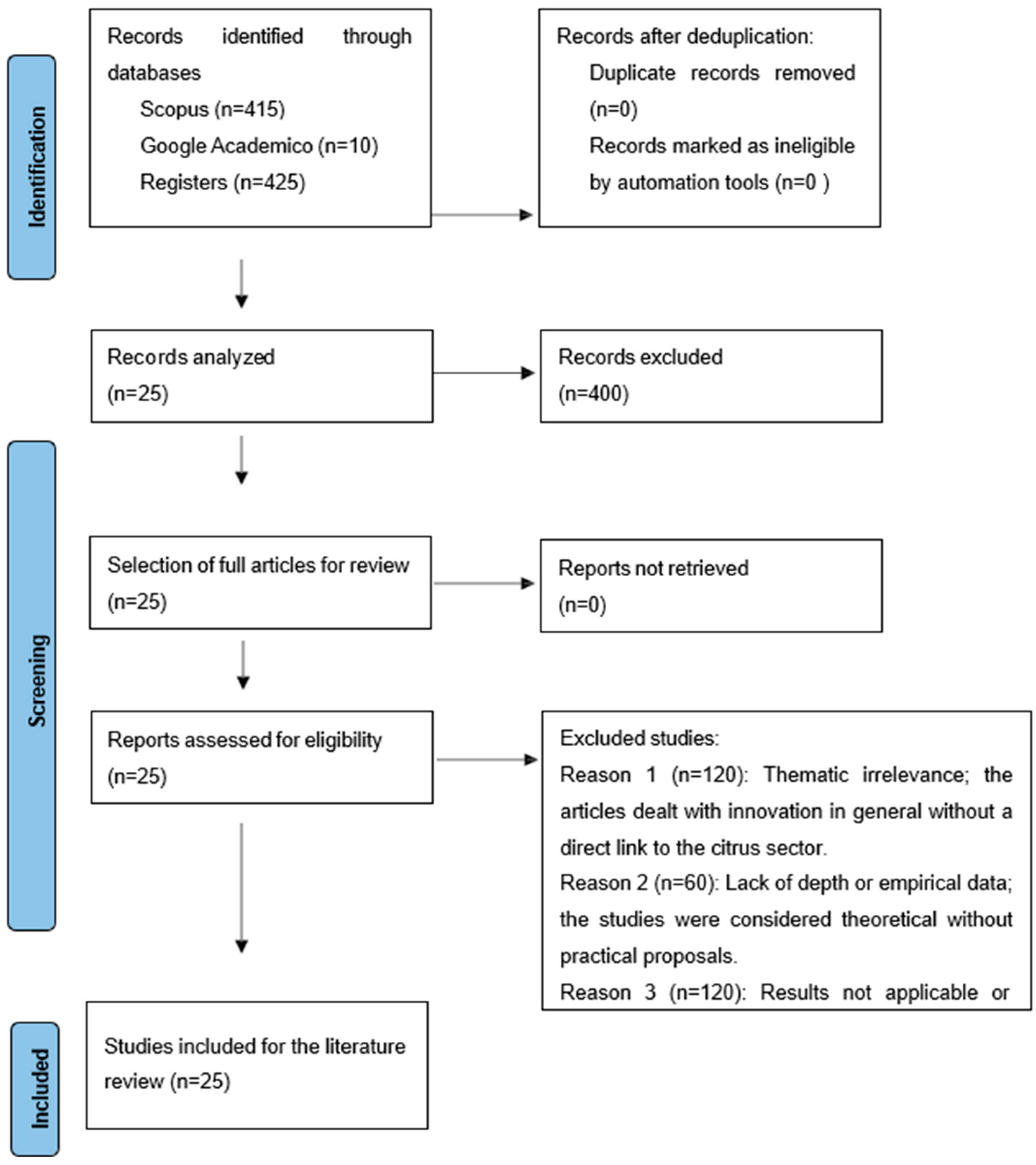
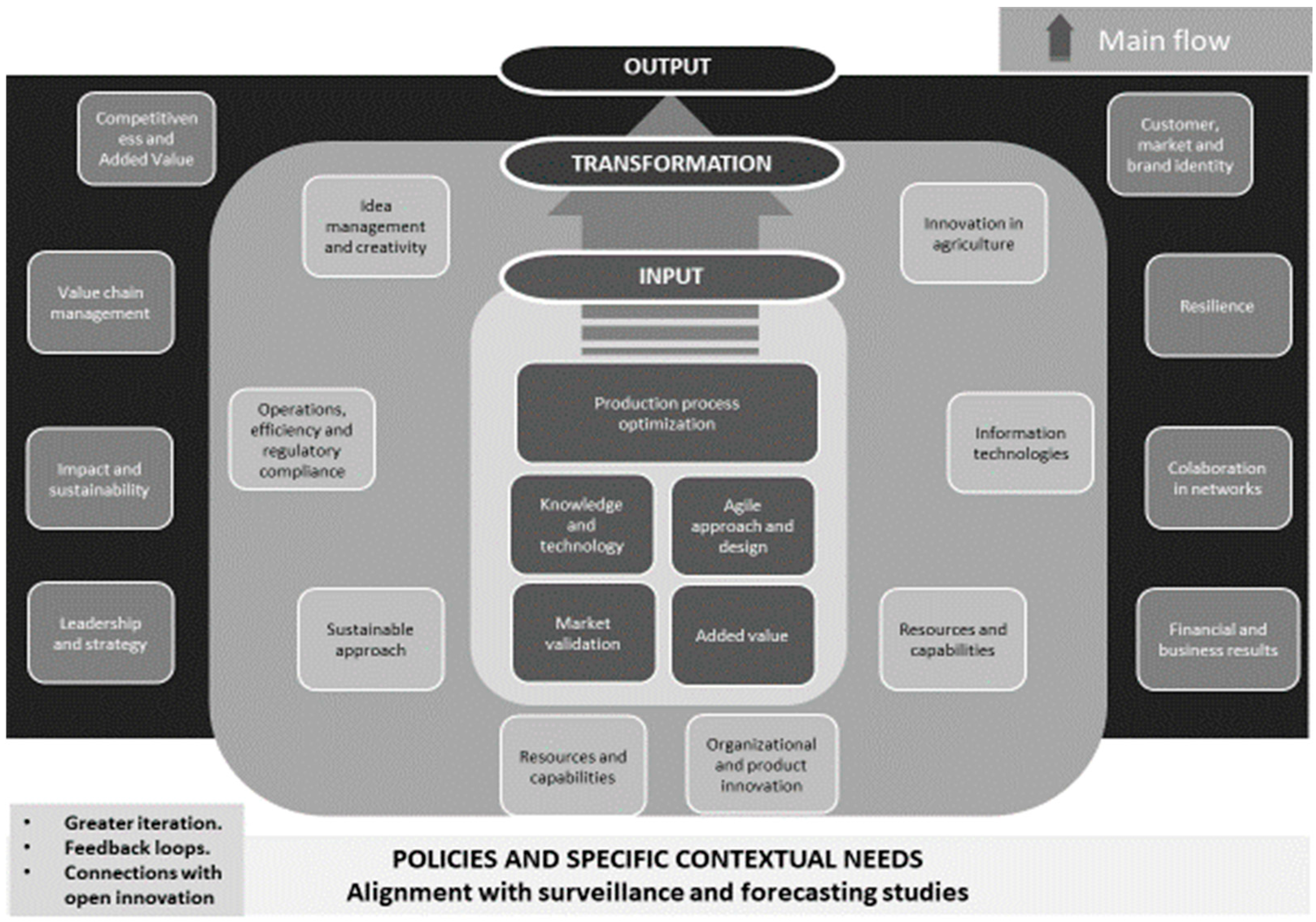
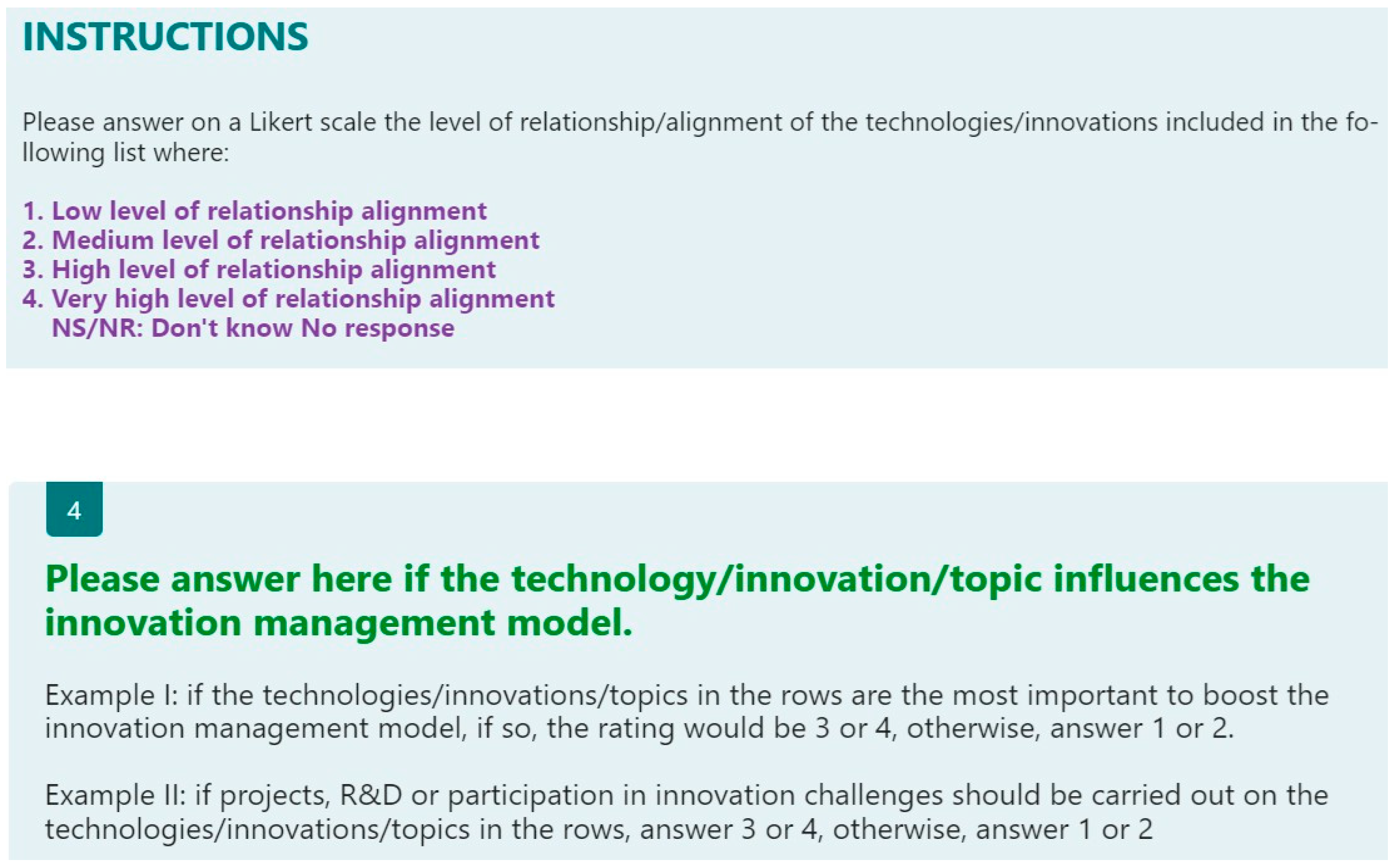
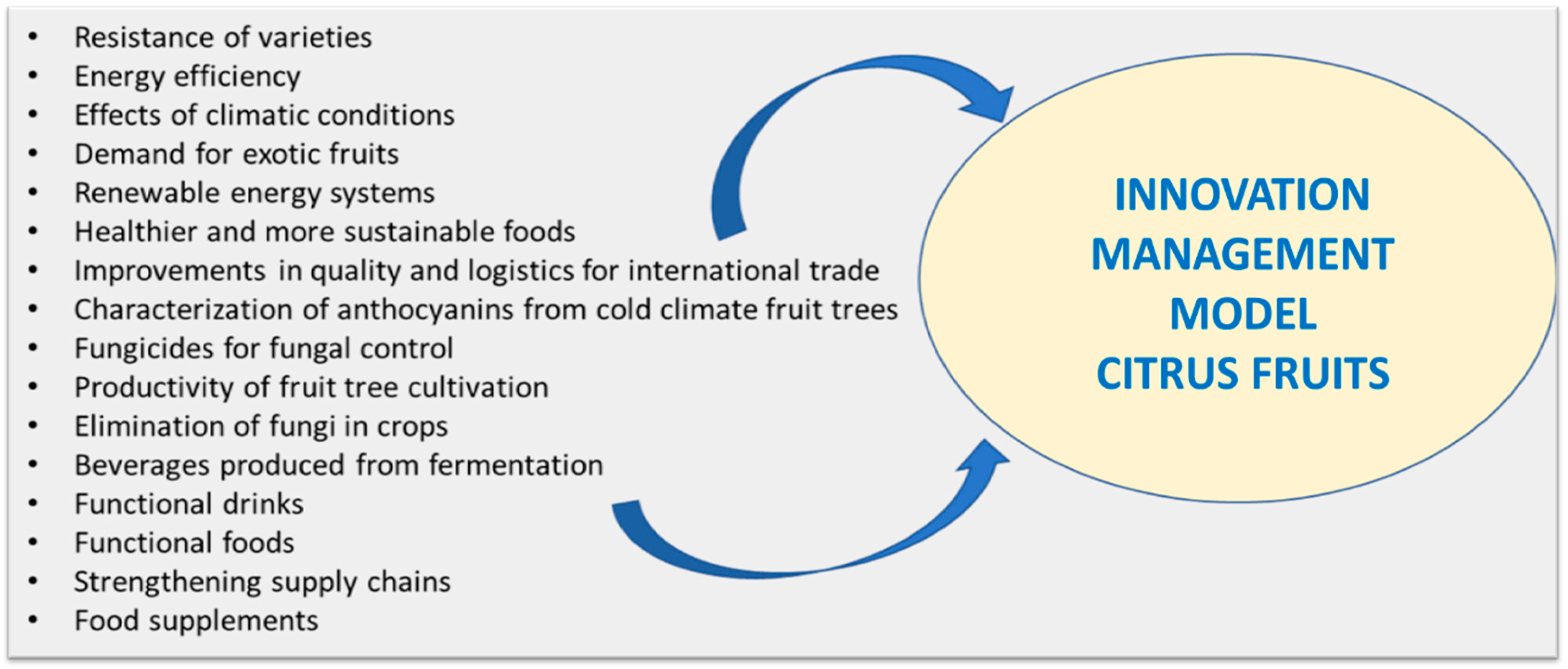
| Organization of the Chain | ||
|---|---|---|
| Thematic tables | National Council | National Technical Secretariat |
| Regional secretariat | Regional committees | Regional secretariat |
| Regional committee | Regional secretariat | Thematic table and regional committee |
| Topic Key | Subtopics | Descriptors | Determinant Factors |
|---|---|---|---|
| The growing interest in the formulation of MGIs highlights the need for R&D&I strategies aligned with organizational models. | What conceptual aspects are considered key in the formulation of MGIs for the generation of new strategies? | MGIs, innovation management, R&D&I. | I Analysis of MGIs correlated with the citrus chain. |
| Does an MGI contribute to the strategy and structure of organizations in the citrus sector? | Alignment of strategies and innovation management models with citrus. |
| Search Equations | Number of Articles | Related Articles |
|---|---|---|
| Equation 1: TITLE-ABS-KEY (innovation AND model AND citrus AND orange AND tangerine) | 2 | 2 |
| Equation 2: TITLE-ABS-KEY (“Management model” OR “Citrus management”) AND (“Citrus” OR “Oranges” OR “Lemons” OR “Mandarins” OR “Grapefruits”) | 221 | 7 |
| Equation 3: TITLE-ABS-KEY (“Innovation management” OR “Innovation model”) AND (“Citrus” OR “Oranges” OR “Lemons” OR “Mandarins” OR “Grapefruits”) | 97 | 0 |
| Equation 4: (TITLE-ABS-KEY (“innovation strategies”) AND TITLE-ABS-KEY “citrus”) | 2 | 2 |
| Equation 5: (TÍTULO-LLAVE-ABS (“innovación”) Y TÍTULO-LLAVE-ABS (“limón”)) | 35 | 1 |
| Equation 6: (TITLE-ABS-KEY (innovation AND management) AND TITLE-ABS-KEY (citrus)) | 58 | 3 |
| Keywords | Related Articles |
|---|---|
| Innovation management models and innovation models. | 10 |
| Inclusion Criteria | Exclusion Criteria |
|---|---|
| Articles on MGIs in the citrus sector that address topics such as the formulation of R&D+i strategies for the citrus industry. | Articles that are not directly related to the citrus sector. |
| Articles that present cases of the implementation of innovation and management models in the citrus fruit sector, with a focus on new methodologies to optimize production and management. | Articles that do not present a practical view of the implementation of innovation management models in the citrus sector. |
| Articles that investigate the relationship between R&D+i policies and the improvement of competitiveness in the citrus market, using innovative management models. | Articles that do not present an analysis of innovative management models in the context of citrus, such as those that focus solely on the general theory of innovation without examining its specific application to the citrus industry. |
| Variables | Mode | Modal Frequency | Percentage of Consensus (%) |
|---|---|---|---|
| 5 | 5 | 83% |
| 5 | 4 | 67% |
| 4 | 5 | 83% |
| 5 | 5 | 83% |
| 4 | 4 | 67% |
| 5 | 4 | 67% |
| 5 | 3 | 60% |
| 5 | 5 | 83% |
| 5 | 5 | 83% |
| 5 | 4 | 67% |
| 5 | 5 | 83% |
| 4 | 4 | 80% |
| 5 | 5 | 83% |
| 5 | 4 | 67% |
| 5 | 5 | 83% |
| 5 | 4 | 67% |
| 5 | 4 | 67% |
| 5 | 4 | 67% |
| 5 | 4 | 67% |
| 5 | 4 | 67% |
| 5 | 4 | 67% |
| 5 | 4 | 67% |
| Variables | Mode | Modal Frequency | Percentage of Consensus (%) |
|---|---|---|---|
| 5 | 5 | 83% |
| 5 | 4 | 67% |
| 5 | 5 | 83% |
| 5 | 4 | 67% |
| 5 | 6 | 100% |
| 5 | 4 | 67% |
| 5 | 5 | 83% |
| 5 | 5 | 83% |
| 5 | 4 | 67% |
| 5 | 4 | 67% |
| 5 | 5 | 83% |
| 5 | 4 | 67% |
| 5 | 4 | 67% |
| 5 | 4 | 67% |
| 5 | 5 | 83% |
| 5 | 5 | 83% |
| 5 | 5 | 83% |
| 5 | 4 | 67% |
| 5 | 5 | 83% |
| Variables | Mode | Modal Frequency | Percentage of Consensus (%) |
|---|---|---|---|
| 5 | 6 | 100% |
| 5 | 5 | 83% |
| 5 | 5 | 83% |
| 5 | 5 | 83% |
| 5 | 5 | 83% |
| 5 | 6 | 100% |
| 5 | 5 | 83% |
| Unassociated Variables | Associated Variables |
|---|---|
| Input Variables | |
| Idea management/creativity, leadership, investment in equipment and infrastructure, engagement, R&D&I activities, innovation management system, Agriculture 4.0 and/or 5.0, sustainable agriculture, agricultural innovation platforms, technological innovation projects, technological development and key technologies, knowledge generation, product quality, innovation objectives, alternative innovation pathways, innovation culture and climate, technological and competitive intelligence and surveillance, information and communication technologies, new production technologies, future production systems, circular economy, university–business–state linkage. | Innovation management and systems. Technological development and agriculture. Research and development and surveillance. Quality and product. Innovation and technologies. Commitment and university–business–state linkage. Circular economy. |
| Transformation Variables | |
| Strategy for innovation management, production process, transformation with added value, development of new products through testing and prototyping, training and knowledge transfer, development of innovative products or processes, knowledge management, technology management, scaling program, sustainable development, circular economy, knowledge management, strategic innovation projects, knowledge networks. | Innovation management, programs, and projects. Process and transformation with added value. Development, training, and knowledge management and networks. Technology and scaling. Foresight, growth, and sustainability. |
| Output Variables | |
| Value creation, product portfolio, profitability of innovation, brand image, organizational resilience, access to new markets, participation in innovation networks. | Value chain and product portfolio. Profitability and access to markets. Image. Participation in networks. Organizational resilience. |
| MGI | Linearity Between Input, Transformation, and Output Variables |
|---|---|
| Authors | Luis Fernando Gutiérrez Cano, Jhon Wilder Zartha Sossa, John Fredy Moreno Sarta, Gina Lía Orozco Mendoza, Tatiana Álvarez Ríos y Juan Carlos Palacio Piedrahita. |
| Description | Information flows and linear relationships between input, transformation, and output variables. |
| Contribution of the model | The contributions of the MGI are presented in the “Results Analysis” Section of the third survey. Outsourcing allows for the knowledge to be transferred to be displayed in different formats, not only from person to person but also from persons to different formats, meaning that the knowledge must be understood in order to be represented in some format. Furthermore, it is the step prior to combination, which allows for increasing, contrasting, detailing, and discerning knowledge through interaction and contributions with other people, with different experiences and interpretations around the same topic. |
| MGI | Feedback/Iterations Between Variables |
|---|---|
| Authors | Luis Fernando Gutierrez Cano, Jhon Wilder Zartha Sossa, John Fredy Moreno Sarta, Gina Lía Orozco Mendoza, Tatiana Álvarez Ríos y Juan Carlos Palacio Piedrahita. |
| Description | Information flows and feedback and iteration between input, transformation, and output variables. Related to policies and the needs of the context. |
| Contribution of the model | The contributions of the MGI are presented in the “Results Analysis” Section of the third survey. |
| MGI | Strategic Alignment and Innovation |
|---|---|
| Authors | Luis Fernando Gutiérrez Cano, Jhon Wilder Zartha Sossa, John Fredy Moreno Sarta, Gina Lía Orozco Mendoza, Tatiana Álvarez Ríos y Juan Carlos Palacio Piedrahita. |
| Description | Iterations between input, transformation, and output variables. Feedback between variables and bidirectional information and knowledge flows. Related to policies and the needs of the context. |
| Contribution of the model | The contributions of the MGI are presented in the “Results Analysis” Section of the third survey. |
Disclaimer/Publisher’s Note: The statements, opinions and data contained in all publications are solely those of the individual author(s) and contributor(s) and not of MDPI and/or the editor(s). MDPI and/or the editor(s) disclaim responsibility for any injury to people or property resulting from any ideas, methods, instructions or products referred to in the content. |
© 2025 by the authors. Licensee MDPI, Basel, Switzerland. This article is an open access article distributed under the terms and conditions of the Creative Commons Attribution (CC BY) license (https://creativecommons.org/licenses/by/4.0/).
Share and Cite
Zartha Sossa, J.W.; Botero Montoya, L.H.; Palacio Piedrahíta, J.C.; González Candia, J.; Gutiérrez Cano, L.F.; Orozco Mendoza, G.L.; Gutiérrez Posada, N.; Hernández Zarta, R.; Gómez Salazar, J.O.; Zapata Valencia, J.C. Sustainable Innovation Management Model (MGI) for Agro-Industrial Citrus Chain. Agriculture 2025, 15, 1069. https://doi.org/10.3390/agriculture15101069
Zartha Sossa JW, Botero Montoya LH, Palacio Piedrahíta JC, González Candia J, Gutiérrez Cano LF, Orozco Mendoza GL, Gutiérrez Posada N, Hernández Zarta R, Gómez Salazar JO, Zapata Valencia JC. Sustainable Innovation Management Model (MGI) for Agro-Industrial Citrus Chain. Agriculture. 2025; 15(10):1069. https://doi.org/10.3390/agriculture15101069
Chicago/Turabian StyleZartha Sossa, Jhon Wilder, Luis Horacio Botero Montoya, Juan Carlos Palacio Piedrahíta, Julio González Candia, Luis Fernando Gutiérrez Cano, Gina Lía Orozco Mendoza, Nolberto Gutiérrez Posada, Raúl Hernández Zarta, José Orlando Gómez Salazar, and Juan Carlos Zapata Valencia. 2025. "Sustainable Innovation Management Model (MGI) for Agro-Industrial Citrus Chain" Agriculture 15, no. 10: 1069. https://doi.org/10.3390/agriculture15101069
APA StyleZartha Sossa, J. W., Botero Montoya, L. H., Palacio Piedrahíta, J. C., González Candia, J., Gutiérrez Cano, L. F., Orozco Mendoza, G. L., Gutiérrez Posada, N., Hernández Zarta, R., Gómez Salazar, J. O., & Zapata Valencia, J. C. (2025). Sustainable Innovation Management Model (MGI) for Agro-Industrial Citrus Chain. Agriculture, 15(10), 1069. https://doi.org/10.3390/agriculture15101069









